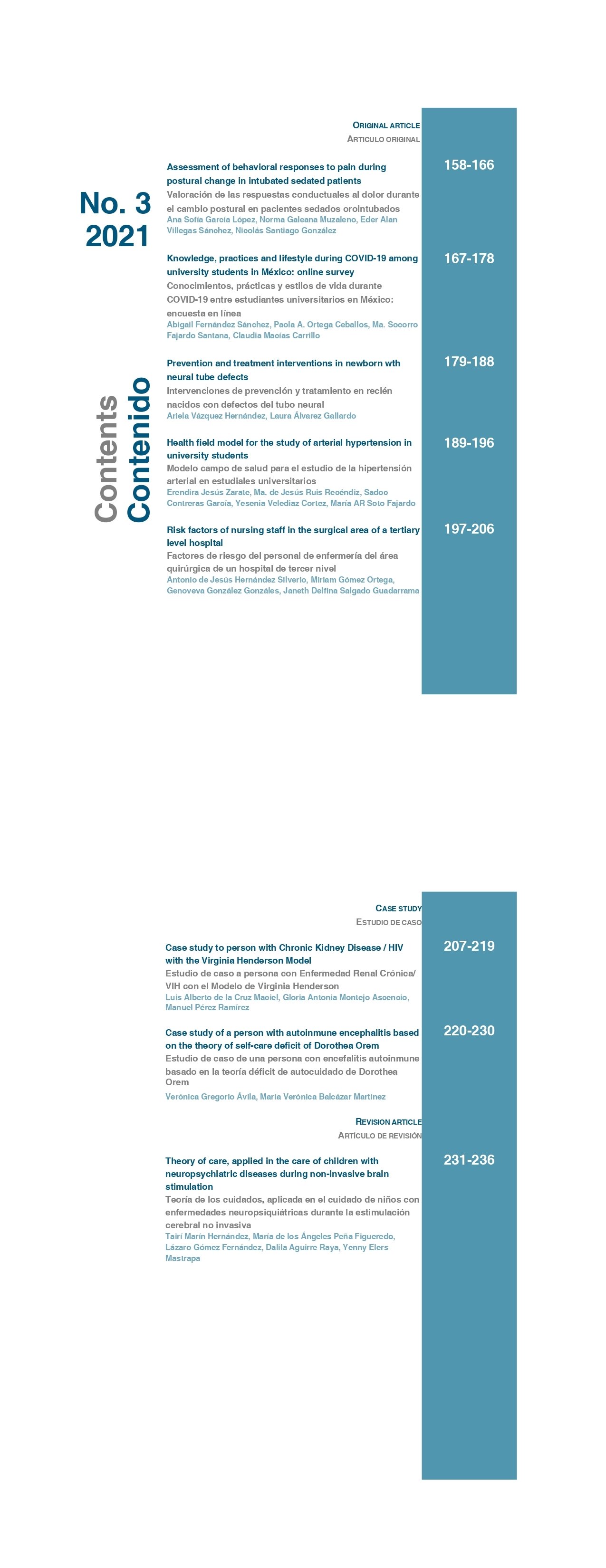Risk factors of nursing staff in the surgical area of a tertiary level hospital
Factores de riesgo del personal de enfermería del área quirúrgica de un hospital de tercer nivel
DOI:
https://doi.org/10.51422/ren.v20i3.340Keywords:
Biosecurity, Nursing, Operating roomAbstract
Introduction: the World Health Organization (WHO) argues that in order to combat infections associated with health care, it is necessary to reduce biosecurity standards for occupational exposed personnel. Biosecurity is to protect quality of life free from damage, risk or danger; nursing staff working in the operating room are exposed to multiple risk factors, such as the use of chemicals to process surgical material; biological factores due to close contact with the patient and body fluids, psychosocial factors, due to workload and tense environments, or ergonomic risks to being in standing positions for long periods of time in surgical procedures.
Objective: to analyze the risk factors of nursing staff in the surgical area of a third-level hospital.
Material and methods: quantitative, descriptive and cross-sectional study. Universe: composed of the nursing staff from the surgical area of a third level hospital. Sample: non-probability at the investigator’s discretion, consisting of 50 operating room nurses of all shifts. Inclusion criteria: all nurses who are working in the surgical area, with more than 2 months in the surgical area. Exclusion criteria: nursing staff who did not sign informed consent and did not wish to participate, nursing staff on leave, vacation, disability, absenteeism, or are not working for some other reason. The instrument: questionnaire consisting of eighty-eight questions, with dichotomous answers, with a reliability of. 99 using Kuder-Richardson formula.
Results: the nursing staff has a biological risk of 100%, in chemical risks: 87%, physical risks: 94%, in terms of psychosocial risks, 94% of the respondents consider they have this risk; for ergonomic risks, 67% of those surveyed reported presenting musculoskeletal injuries.
Conclusion: nursing professionals in the surgical area are exposed to different risks. These hazards affect individually and collectively, it has the probability of triggering a health disturbance, inevitably affecting the work process, leads to poor work performance and non-compliance with objectives in public and private institutions. Adherence to biosafety measures must be observed in the surgical unit to reduce the risks of infectious and contagious diseases.
Downloads
References
Miranda-López Rosa I, Montero-Varela . Incidencia de accidentes laborales en el personal de enfermería. Rev Enferm 15. Recuperado:octubre 2018, de https://bit.ly/3zAM207
Ministerio de Salud. Guía de bioseguridad para los profesionales sanitarios. 2010 Recuperado:diciembre 2018, de en https://bit.ly/3NMePms
Lenz Osear Badani O. Bioseguridad en el quirófano procedimientos. Rev Act Clin Med. 2011 Obtenido de https://bit.ly/3zwQQ6F
Organización Internacional del trabajo. (c). Seguridad y salud en centros de trabajo. 2011. Recuperado:22 junio 2019, de https://bit.ly/3Hh35WG
Organización Panamericana de la Salud. Riesgos con efectos potenciales y controles. 2011 Recuperado:2 diciembre 2018, de http://www.bvsde.ops-oms.org/ssmanual/Spanish/modulos3.pdf
Padilla-Languré M, García-Puga Julio A, Salazar-Ruibal Rosa M, Figueroa Ibarra Claudia, et al. Normas de bioseguridad del personal de enfermería en una institución hospitalaria. Biotecnia.2016;18(E2):29-33. https://bit.ly/3NS2Pjq DOI: https://doi.org/10.18633/bt.v18i1.225
Coria Lorenzo José J, Aguado Huerta Gloria, González Oliver Angélica, Águila Torres Rosa L. Vázquez Flores Adalberto, Pérez Robles Víctor M. Lesiones por riesgo ocupacional con diferentes dispositivos entre profesionales de atención a la y sus jornadas de trabajo en un hospital de tercer nivel 2003-2013. Rev Latin Infect Pediatr.2017;30(1):15:21. https://bit.ly/3zzSKmQ
Gómez Ceballos Diego A, Muñoz Marín Diana P. Caracterización de los accidentes laborales en un hospital de la región de Antoquia Colombia. Rev Cub Sal Trabajo.2015;16(2):31-6. https://bit.ly/3n1r8zP
Downloads
Published
How to Cite
Issue
Section
License
Copyright (c) 2022 Revista de Enfermería Neurológica

This work is licensed under a Creative Commons Attribution-NonCommercial 4.0 International License.






